Forget the Grill: Your Ultimate Guide to Perfect Air Fryer Peaches
I’m going to be straight with you. When air fryers first hit the scene, a lot of us in the professional cooking world kind of rolled our eyes. We saw them as glorified mini-ovens. But after years of putting them through their paces, I’ve come to really respect these machines for certain jobs. And one of those jobs is making caramelized fruit.
In this article
Honestly, a properly made air fryer peach can go toe-to-toe with one made on a grill or in a pan, but with way less fuss. The best part? You can pull this off in under 20 minutes from start to finish. This isn’t just a quick recipe dump, though. We’re going to get into the nitty-gritty of why this works so you can nail it every single time.
The Kitchen Science of a Perfect Peach
To really master a dish, you have to understand what’s happening under the hood. When you pop a sugared-up peach into that hot basket, you’re kicking off a couple of key reactions that create all that amazing flavor.
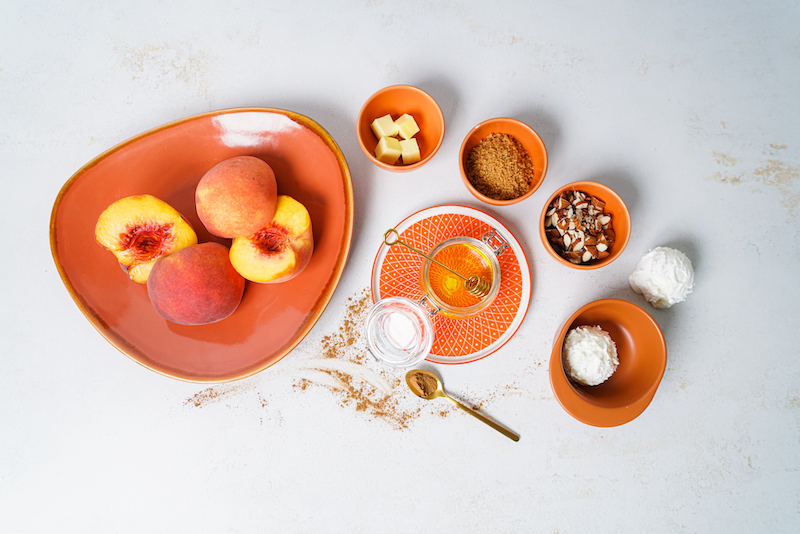
First up is caramelization. This is pretty simple: it’s the browning of sugar. When the brown sugar you sprinkle on top hits a certain temperature (around 340°F), its molecules break down and reform into new compounds that are nutty, complex, and deeply delicious. That’s where the classic caramel flavor comes from.
But there’s another, more complex process at play: the Maillard reaction. Think of this as the savory browning you get on a seared steak or fresh-baked bread. It’s a reaction between amino acids (from the peach and the butter) and sugars. It creates hundreds of new flavor and aroma notes that are much deeper than caramelization alone. That little pat of butter you add isn’t just for richness; its milk solids are fuel for this incredible flavor-building reaction.
So, why is an air fryer so good at this? It’s basically a mini-hurricane of hot air. This intense, circulating air zaps moisture from the peach’s surface almost instantly. This does two things: it concentrates the natural sugars in the fruit, making it taste even peachier, and it creates a dry surface that’s perfect for browning. In a regular oven, the process is slower, and you risk the peaches turning to mush before they ever get that beautiful crust.
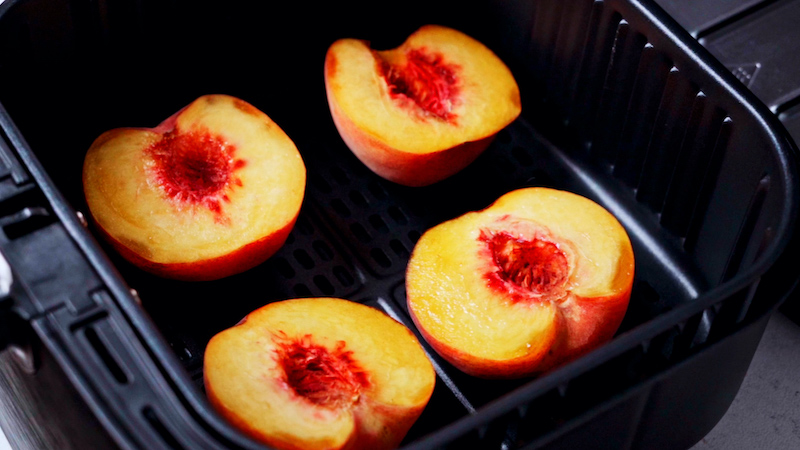
Your Shopping List: Quality is Everything
With a dish this simple, there’s nowhere for bad ingredients to hide. A bland, mealy peach will give you a bland, mealy result. No amount of cooking magic can fix that. Here’s what you’ll need for two people (or one very happy person).
- Two ripe but firm freestone peaches. This is the most important part. Freestone means the flesh doesn’t cling to the pit, so you can easily twist it open. Clingstone peaches, which you often see early in the season, will turn into a mangled mess. Good in-season peaches might run you $1.00 to $2.00 each, but they are absolutely worth it.
- Two tablespoons of unsalted butter, cold and cut into four small pats.
- About 1/4 cup of light brown sugar. It has a bit of molasses that adds a lovely depth that plain white sugar just can’t match.
- One teaspoon of cinnamon. Or more, if you love it.
- A tiny pinch of fine sea salt. Seriously, don’t skip this! It makes the sweet flavors pop.
A quick word on the peel: To peel or not to peel? Honestly, I leave the skin on. It helps the peach half hold its shape during cooking and adds a nice bit of texture and color. Plus, it’s way easier. If you really can’t stand the skin, you can quickly blanch the peaches in boiling water for 30 seconds, then shock them in ice water—the skins will slip right off. It’s an extra step, but you do you.

Oh, and what about frozen or canned peaches? To be frank, I wouldn’t recommend it. They hold too much water and tend to get mushy. You’ll lose that perfect tender-crisp texture that makes this dish so good. If you’re in a pinch, you could try with thawed, very well-drained frozen slices, but fresh is king here.
The Step-by-Step Method to Peach Perfection
First, let’s talk tools. You’ll want a sharp paring knife and, this is my big pro tip, perforated parchment paper liners for your air fryer. Molten sugar is like superglue. These liners make cleanup a breeze and still let the hot air circulate. You can grab a box of 100 for about $8 online, and they’ll last you ages.
- Preheat the Air Fryer. Set your machine to 380°F (195°C) and let it run for about 5 minutes while you prep. Starting with a hot basket helps kickstart the caramelization.
- Prep the Peaches. Wash and pat the peaches completely dry. A wet peach will steam instead of roast. Slice them in half along the natural seam and twist to separate. Pop out the pit.
- Arrange in the Basket. Place a liner in your preheated basket. Arrange the peach halves cut-side up, leaving at least an inch of space between them. This is critical! Overcrowding traps steam and makes everything soggy. For reference, my 6-quart basket fits four halves (two peaches) perfectly. If you have a smaller 4-quart model, you’ll definitely need to cook in batches.
- Add the Topping. Place a small pat of cold butter in the little cavity where the pit was. In a small bowl, mix your brown sugar, cinnamon, and that tiny pinch of salt. Sprinkle this mixture generously all over the cut surface of the peaches.
- Time to Cook. Air fry for 8 to 12 minutes. Every machine is different, so use your senses. After 6 minutes, take a peek. You should see the sugar bubbling and the edges turning a deep amber. It should smell incredible. They’re done when the tip of a knife slides into the flesh with very little resistance.
- Let Them Rest! Carefully remove the peaches and let them sit on a plate for at least two minutes. That molten sugar is insanely hot and needs a moment to cool and set into a perfect glaze.
Quick Tip: If your air fryer tends to run hot or you’re just nervous about burning the sugar, try this. Cook the peaches plain for the first 5 minutes. Then, carefully pull out the basket, add the butter and sugar topping, and pop it back in for the last 5 to 7 minutes. This gives the peach a head start and makes it much harder to burn the topping.
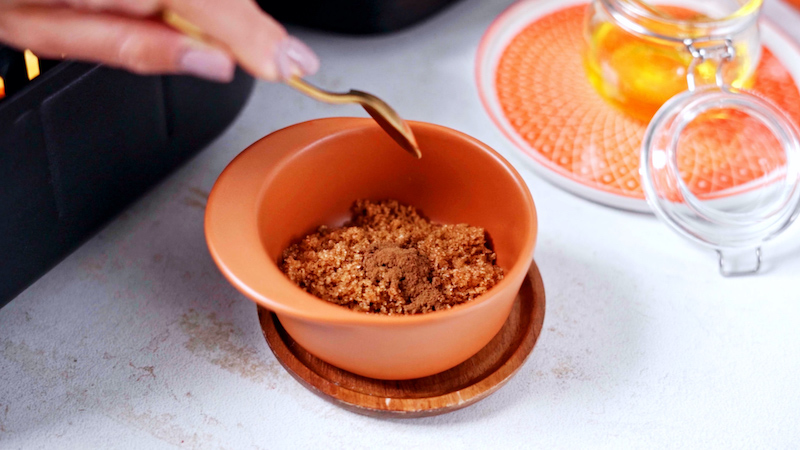
Troubleshooting Common Problems
Things don’t always go right the first time. It happens! Here are a few common issues and how to fix them.
- The Problem: My peaches are a soggy, mushy mess.
The likely cause is either your peaches were already overripe and too soft, or you crammed too many in the basket. The fix is to choose firmer fruit next time and always cook in a single, uncrowded layer. - The Problem: The sugar burned before the peach was soft.
Your air fryer probably runs hot (the temperature dials are rarely perfect). Next time, try the two-stage cooking method mentioned above, or just lower the temp to 360°F and keep a close eye on it. - The Problem: Everything is welded to the basket.
You skipped the liner, didn’t you? That melted sugar is a powerful glue. A perforated parchment liner is your best friend here. If they’re already stuck, let them cool a bit—sometimes the sugar will release its death grip as it sets.
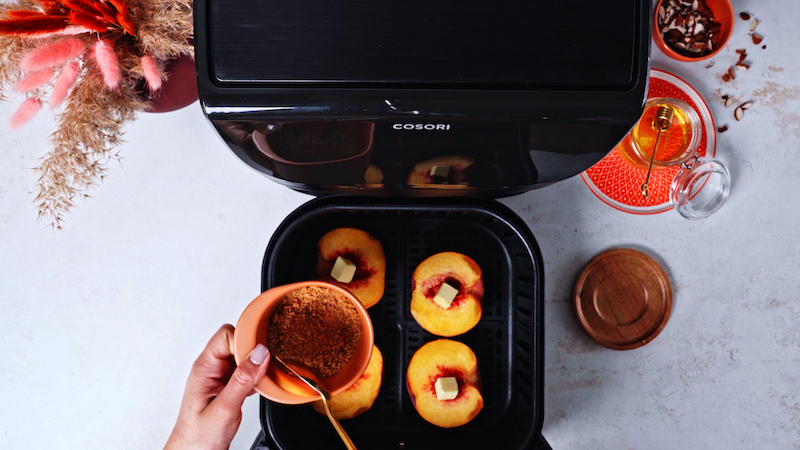
Let’s Get Creative: Fun Variations
Once you’ve nailed the basic technique, this dish becomes a fantastic canvas for creativity.
- Southern-Style: Mix some finely chopped pecans into the sugar topping. When they come out of the fryer, drizzle with a splash of good bourbon. The oak and vanilla notes are a match made in heaven with peaches.
- Mediterranean Twist: Swap the cinnamon for a pinch of cardamom and use crushed pistachios for crunch. Serve it with a big dollop of thick Greek yogurt instead of ice cream for a tangy, refreshing finish.
- Savory Surprise: Yes, really! Cut the sugar in half and toss a sprig of fresh thyme or rosemary into the basket while they cook. The herby, fragrant peaches are an amazing side for grilled pork chops or duck breast.
Serving, Storing, and a Serious Safety Warning
The classic way to serve these is with a scoop of good vanilla bean ice cream. The hot-and-cold contrast is just unbeatable. Mascarpone cheese or crème fraîche are also fantastic, less sweet options.
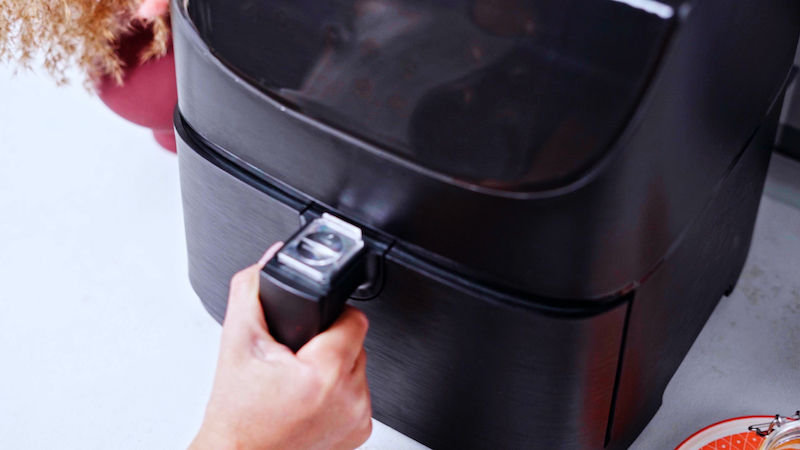
As for leftovers, they’re best eaten immediately. If you must, you can store them in an airtight container in the fridge for a day or two. To reheat, pop them back in the air fryer at 350°F for a couple of minutes to re-crisp the top. Please, whatever you do, do not microwave them. It will turn them into a sad, soggy tragedy.
Heads up! A VERY important safety note. Molten sugar is no joke. It’s hotter than boiling water and sticky, meaning it can cause very serious burns. Never, ever touch the topping right out of the air fryer. Always warn your guests, especially kids, that the center is extremely hot. Be careful, and enjoy every bite.
Recipe in a Nutshell (For the Skimmers)
- Prep: Preheat air fryer to 380°F. Halve 2 freestone peaches and remove pits.
- Top: Place a pat of butter in each peach half. Mix 1/4 cup brown sugar, 1 tsp cinnamon, and a pinch of salt. Sprinkle over peaches.
- Cook: Arrange in a single layer in a lined basket. Air fry for 8-12 minutes, until tender and bubbly.
- Serve: Rest for 2 minutes before serving with ice cream. Be careful, the topping is hot!
Inspiration:
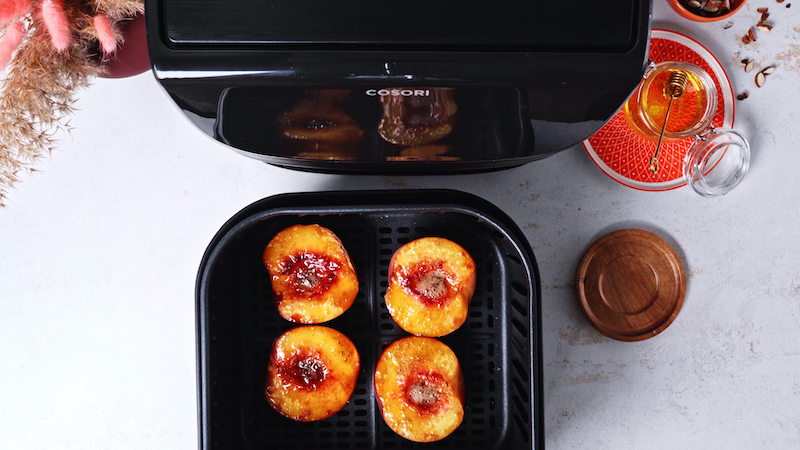
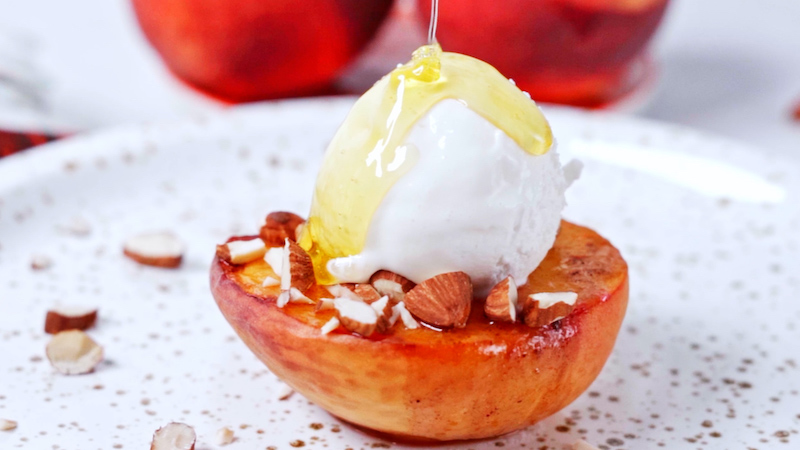
What if my peaches are rock-hard or a bit too soft?
The ideal peach for this recipe is ripe but still firm to the touch. This texture allows it to soften beautifully without collapsing into mush. If your peaches are under-ripe, they’ll struggle to become tender and sweet; better to let them sit on the counter for a day. If they’re already very soft, you can still use them, but reduce the air frying time by 1-2 minutes to prevent them from turning into peach sauce.
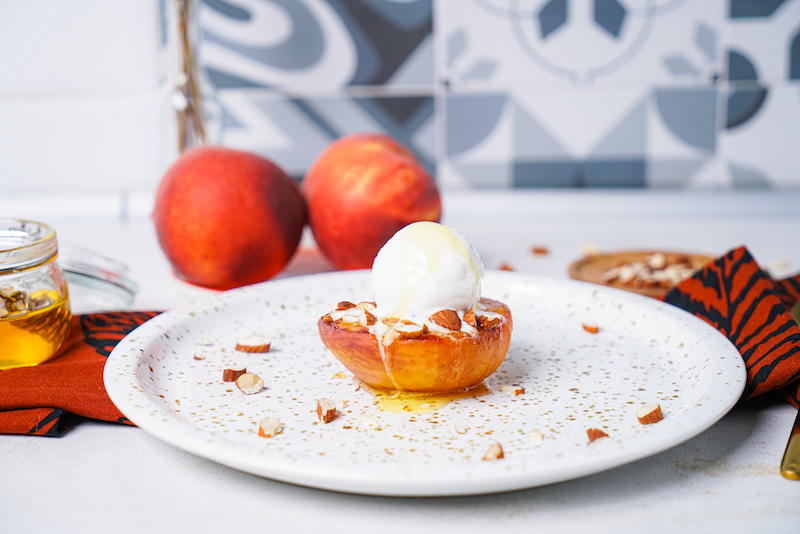
The Maillard reaction, crucial for that deep flavor, begins to occur rapidly at temperatures above 285°F (140°C).
Your air fryer’s intense, circulating heat is perfect for hitting this temperature quickly on the peach’s surface. The small pat of butter mentioned in the recipe isn’t just for richness; the milk solids in it provide the amino acids that react with the fruit’s sugar, supercharging the Maillard reaction and creating those complex, toasty notes that simple caramelization can’t achieve alone.
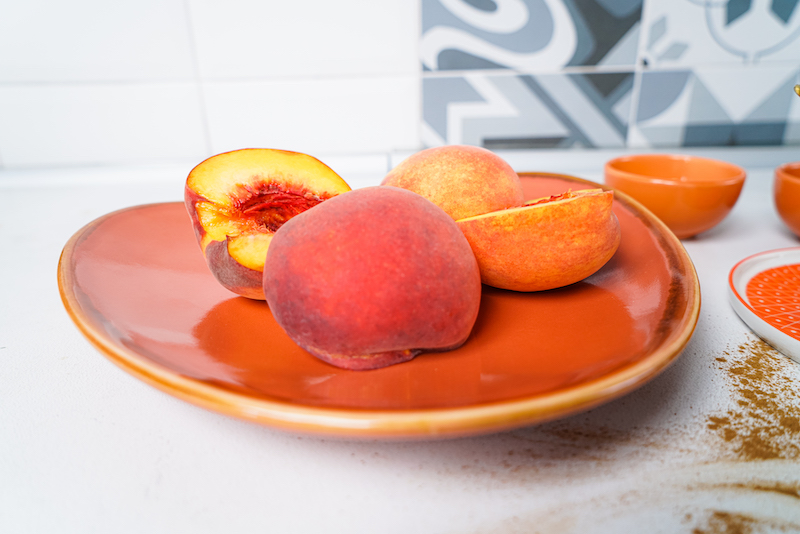
Bare Basket: Cooking directly on the non-stick surface allows for maximum air circulation, potentially creating a slightly more even browning on the underside of the peach.
Parchment Liner: Using a perforated air fryer liner (like those from Reynolds or generic brands) catches all the molten sugar and butter, making cleanup effortless.
For a sticky, sugary recipe like this one, the liner is a clear winner. You sacrifice a tiny bit of airflow for the massive convenience of not having to scrub baked-on caramel from the basket.
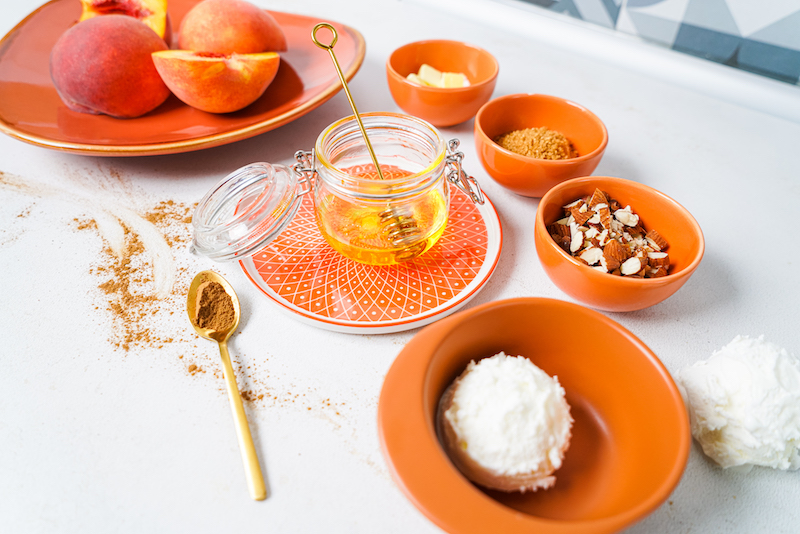
- A surprising contrast of sweet, salty, and creamy.
- An elegant appetizer that looks incredibly sophisticated.
- A perfect centerpiece for a weekend brunch.
The secret? Think beyond dessert. Serve your warm air-fried peaches alongside a creamy ball of burrata, a few slices of prosciutto, and a drizzle of high-quality balsamic glaze. It’s a game-changer.
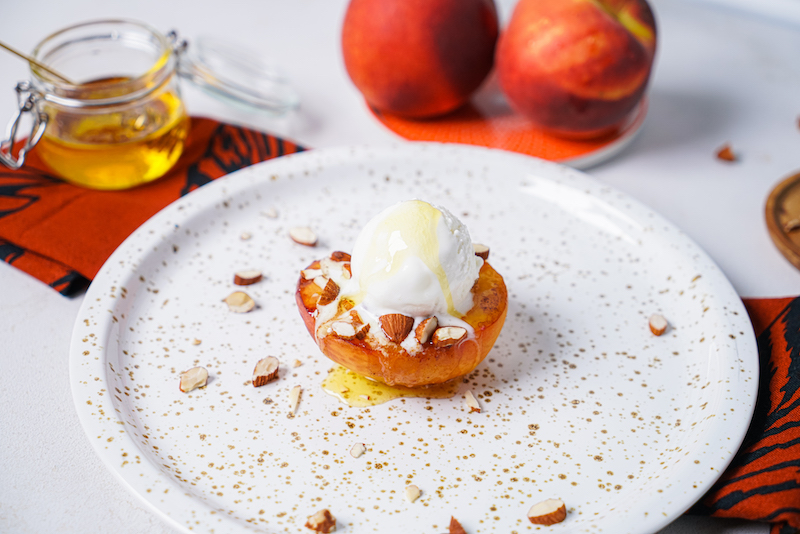
Expert Tip: Don’t overcrowd the basket. This is the cardinal rule of air frying, and it’s especially true here. The peaches need space for the hot air to circulate freely around each half. Placing them too close together will cause them to steam rather than roast, leaving you with soft, pale fruit instead of beautifully caramelized gems. If cooking for a crowd, work in batches. Your patience will be rewarded.
Once you’ve mastered the basic recipe, it becomes a canvas for creativity. Try these flavor variations:
- Warm Spice: Mix a pinch of cardamom or allspice into the brown sugar.
- Savory Herb: Tuck a small sprig of fresh thyme or rosemary alongside the peaches in the basket. The aroma will subtly infuse the fruit.
- A Boozy Kick: Add a teaspoon of bourbon or dark rum to the butter before brushing it on.










